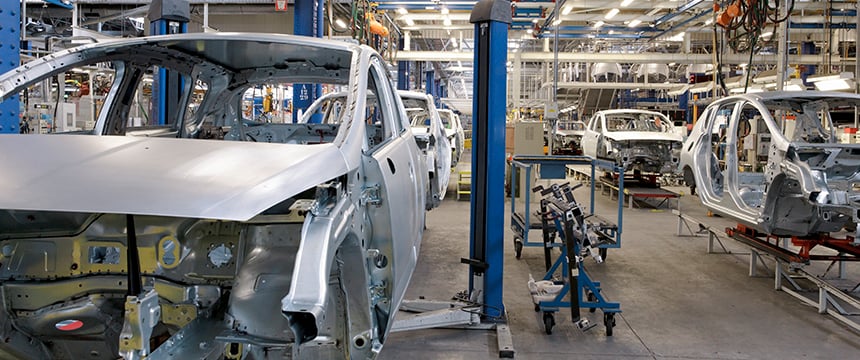
The supply chain is the lifeblood of the automotive manufacturing industry. Disruptions to the supply chain caused by COVID-19 and component and material shortages, such as the semiconductor industry shortage, have put this into sharp focus. Given the recent impacts of the pandemic and shortages to companies’ supply chains, we have seen a serious focus on supply chain strategy, which requires input and buy-in from supply chain managers, procurement and executives. There are a series of trends that we are seeing automotive manufacturers implement, which are discussed in greater detail below:
- Procurement model that looks beyond the lowest cost supplier
- Right-shoring considerations
- Transparency in the supply chain
- Enhanced cybersecurity
First, although pricing and cost always will be driving factors in sourcing decisions, automotive companies are beginning to lessen their focus on sole sourcing and Just-In-Time (JIT) delivery from the lowest cost supplier.1 Many automotive companies are taking additional steps to ensure a more stable and resilient supply chain through strategic changes to their procurement model and/or contract changes. Where possible, many automotive companies are considering dual-sourcing, on-site and off-site warehousing options to ensure that they have a bank of parts available and taking steps to diversify their third-party logistics providers. On the commercial contracting side, as a result of tough lessons learned during the pandemic, automotive companies are reexamining the standard force majeure provisions in their contracts to ensure that they are properly tailored to: (i) encompass past force majeure events and events that may cause disruptions in the future; (ii) focus on rights and obligations depending upon whether the company is a buyer or seller2</sup>; and (iii) allocate risk, including the series of costs that may not have been previously spelled out in the contract, like freight expedites, return costs, overtime, etc., that were necessarily incurred during the pandemic shutdowns and restart.
Second, for some components, automotive companies are considering options to move away from sourcing in China and analyzing the cost versus risk mitigation benefits from shifting their supply chains away from China to other countries. The term “right-shoring” refers to locating a business’s manufacturing operations in localities and countries that provide the best combination of cost and efficiency.3 As started happening after the implementation of the tariffs and trade wars commencing in 2018, some automotive manufacturers were considering moving away from China as a major manufacturing hub and looking at other options. Alternatives include reshoring to the U.S., near-shoring to Mexico or Canada, or exploring options in parts of Southeast Asia (Vietnam and Thailand are key locations being considered), India or Latin America (Brazil is a key location being considered).4 When weighing the pros and cons of locations, companies always will consider cost of materials, property prices, labor costs, labor regulations, IP protections and logistics. Notably, China continues to be the main manufacturing hub and sourcing location for certain key electronic components, which will continue to be sourced from China and will become increasingly important with the industry’s movement to electrification.
Third, automotive companies are taking short- and long-term actions to create more visibility within their supply chains and increasing transparency throughout their supply chains in order to mitigate against future risks. Manufacturers that were able to successfully navigate the pandemic noted the importance of having transparency in all aspects of their supplier’s supply chain, from material providers to facility locations to logistics. Companies that have not already done so are looking at options to digitize their supply chain in order to have real-time visibility into any potential or existing disruptive factors. Of course, this sort of transparency from raw material inputs to end-customer deliverables would require data from all sub-suppliers in a company’s supply chain. Traditionally, certain aspects of an automotive supplier’s supply base and logistics have been considered to be proprietary and confidential information. However, we already are seeing pressure by OEMs to Tier 1 suppliers to provide more information regarding their sub-suppliers, sourcing locations and even pricing information. Although obtaining this level of detail into their suppliers’ operations may be useful for navigating future issues and mitigating supply chain disruptions, we expect that automotive suppliers will resist providing certain pricing and cost details that would allow an OEM unwelcome insight into a supplier’s pricing model or even present antitrust issues in the automotive industry.
Fourth, with growing technology in both the automotive supply chain and in smart vehicles, automotive companies need to plan to enhance their cybersecurity measures. Automotive manufacturers are rolling out detailed policies that incorporate industry best practices, including SAE guidelines.5
In short, there are a number of concerns and lessons learned that are driving changes in automotive companies’ supply chain strategy and best practices. However, cost and pricing will continue to be the main considerations in any sourcing model.
——————————————————–
1 “The End of Just-In-Time,” Reuters Events https://www.reutersevents.com/supplychain/supply-chain/end-just-time
2 “Force Majeure Tug-Of-War: Competing Interests of Buyers and Sellers Negotiating Force Majeure Protections in Supply Chain Contracts,” Vanessa Miller https://www.foley.com/en/insights/publications/2020/07/force-majeure-competing-interests-buyers-sellers
3 “Right-Shoring,” Will Kenton, Investopedia https://www.investopedia.com/terms/r/right-shoring.asp
4 See Patrick Van den Bossche et al., Trade War Spurs Sharp Reversal in 2019 Reshoring Index, Foreshadowing COVID-19 Test of Supply Chain Resilience, KEARNEY, https://www.kearney.com/documents/20152/5708085/2020%20Reshoring%20Index.pdf/ba38cd1e-c2a8-08ed-5095-2e3e8c93e142?t=1586268199800&utm_medium=pr&utm_source=prnewswire&utm_campaign=2020ReshoringIndex
5 Society of Automotive Engineers. (2016). SAE Standard J 3061: Cybersecurity Guidebook for Cyber-Physical Vehicle Systems. (Web page). Warrendale, PA: Author. Available at http://standards.sae.org/wip/j3061/

